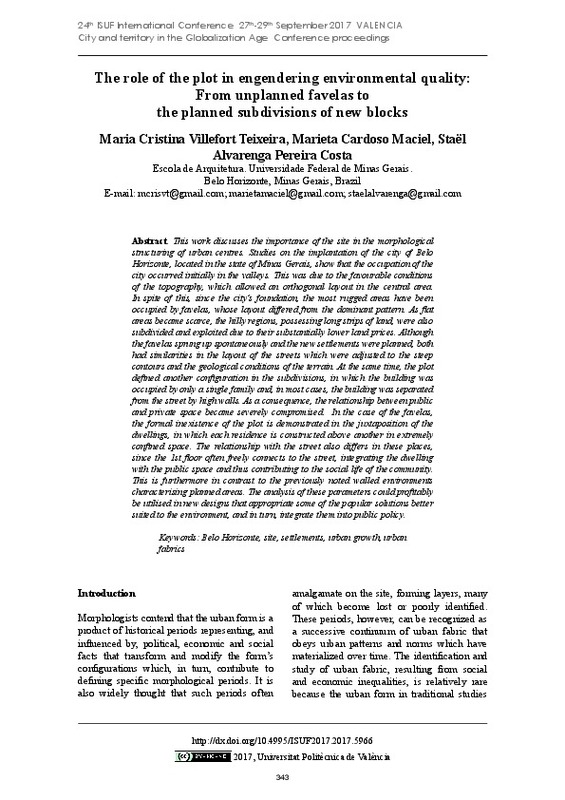JavaScript is disabled for your browser. Some features of this site may not work without it.
Buscar en RiuNet
Listar
Mi cuenta
Estadísticas
Ayuda RiuNet
Admin. UPV
The role of the plot in engendering environmental quality: from unplanned favelas to the planned subdivisions of new blocks
Mostrar el registro sencillo del ítem
Ficheros en el ítem
| dc.contributor.author | Teixeira, Maria Cristina
|
es_ES |
| dc.contributor.author | Maciel, Marieta
|
es_ES |
| dc.contributor.author | Pereira Costa, Staël
|
es_ES |
| dc.coverage.spatial | east=-43.9344931; north=-19.9166813; name=Centro, Belo Horizonte - State of Minas Gerais, 30111-040, Brasil | es_ES |
| dc.date.accessioned | 2018-12-19T07:53:21Z | |
| dc.date.available | 2018-12-19T07:53:21Z | |
| dc.date.issued | 2018-04-20 | |
| dc.identifier.isbn | 9788490485743 | |
| dc.identifier.uri | http://hdl.handle.net/10251/114149 | |
| dc.description.abstract | [EN] This work discusses the importance of the site in the morphological structuring of urban centres. Studies on the implantation of the city of Belo Horizonte, located in the state of Minas Gerais Brazil, show that the occupation of the city occurred initially in the valleys. This was due to the favourable conditions of the topography, which allowed an orthogonal layout in the central area. In spite of this, since the city’s foundation, the most rugged areas have been occupied by favelas, whose layout differed from the dominant pattern. As flat areas became scarce, the hilly regions, possessing long strips of land, were also subdivided and exploited due to their substantially lower land prices. Although the favelas sprung up spontaneously and the new settlements were planned, both had similarities in the layout of the streets which were adjusted to the steep contours and the geological conditions of the terrain. At the same time, the plot defined another configuration in the subdivisions, in which the building was occupied by only a single family and, in most cases, the building was separated from the street by high walls. As a consequence, the relationship between public and private space became severely compromised. In the case of the favelas, the formal inexistence of the plot is demonstrated in the juxtaposition of the dwellings, in which each residence is constructed above another in extremely confined space. The relationship with the street also differs in these places, since the first floor often freely connects to the street, integrating the dwelling with the public space and thus contributing to the social life of the community. This is furthermore in contrast to the previously noted walled environments characterising planned areas. The analysis of these parameters could profitably be utilised in new designs that appropriate some of the popular solutions better suited to the environment, and in turn, integrate them into public policy. | es_ES |
| dc.description.sponsorship | Authors acknowledge the support received from Fundação de Amparo à Pesquisa de Minas Gerais -FAPEMIG, from Conselho Nacional de Desenvolvimento Tecnológico e Cientifico- CNPq and Cordenação de Aperfeiçoamento de Pessoal de Nível Superior - CAPES for the development of this paper | es_ES |
| dc.format.extent | 9 | es_ES |
| dc.language | Inglés | es_ES |
| dc.publisher | Editorial Universitat Politècnica de València | es_ES |
| dc.relation.ispartof | 24th ISUF International Conference. Book of Papers | es_ES |
| dc.rights | Reconocimiento - No comercial - Sin obra derivada (by-nc-nd) | es_ES |
| dc.subject | Belo Horizonte | es_ES |
| dc.subject | Site | es_ES |
| dc.subject | Settlements | es_ES |
| dc.subject | Urban growth | es_ES |
| dc.subject | Urban fabrics | es_ES |
| dc.title | The role of the plot in engendering environmental quality: from unplanned favelas to the planned subdivisions of new blocks | es_ES |
| dc.type | Capítulo de libro | es_ES |
| dc.type | Comunicación en congreso | es_ES |
| dc.identifier.doi | 10.4995/ISUF2017.2017.5966 | |
| dc.rights.accessRights | Abierto | es_ES |
| dc.description.bibliographicCitation | Teixeira, MC.; Maciel, M.; Pereira Costa, S. (2018). The role of the plot in engendering environmental quality: from unplanned favelas to the planned subdivisions of new blocks. En 24th ISUF International Conference. Book of Papers. Editorial Universitat Politècnica de València. 343-351. https://doi.org/10.4995/ISUF2017.2017.5966 | es_ES |
| dc.description.accrualMethod | OCS | es_ES |
| dc.relation.conferencename | 24th ISUF 2017 - City and Territory in the Globalization Age | es_ES |
| dc.relation.conferencedate | Septiembre 27-29,2017 | es_ES |
| dc.relation.conferenceplace | Valencia, Spain | es_ES |
| dc.relation.publisherversion | http://ocs.editorial.upv.es/index.php/ISUF/ISUF2017/paper/view/5966 | es_ES |
| dc.description.upvformatpinicio | 343 | es_ES |
| dc.description.upvformatpfin | 351 | es_ES |
| dc.type.version | info:eu-repo/semantics/publishedVersion | es_ES |
| dc.relation.pasarela | OCS\5966 | es_ES |
| dc.contributor.funder | Fundação de Amparo à Pesquisa do Estado de Minas Gerais | |
| dc.contributor.funder | Conselho Nacional de Desenvolvimento Científico e Tecnológico, Brasil | |
| dc.contributor.funder | Coordenaçao de Aperfeiçoamento de Pessoal de Nível Superior, Brasil |








